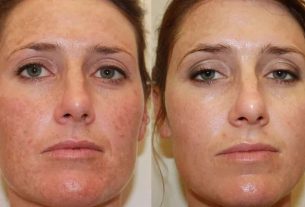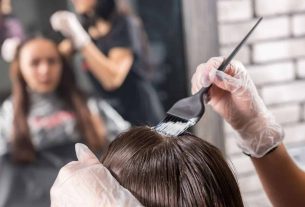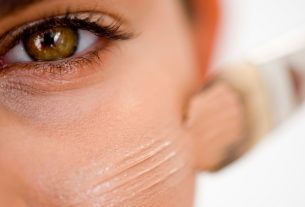Hair sealing is a treatment that uses keratin and the application of heat to promote the restructuring of strands, reducing frizz and leaving hair softer, hydrated and with less volume.
This procedure is mainly recommended for damaged hair, which has suffered from the action of dyes and chemical procedures for a long time and which needs an intense replacement of nutrients.
Sealing can be done by a professional or at home, as long as the person has the necessary products and uses them according to the hairdresser’s instructions, because, depending on the quantity used and the type of product, the effect may not be as expected. , making it necessary to repeat the sealing shortly afterwards.

What is it for
Hair sealing serves to renew strands, and is mainly recommended for hair damaged by chemicals, such as straightening and coloring, or by frequent use of straighteners or brushes, without heat protection.
This is because this treatment closes the cuticles and promotes hydration of the strands, causing the hair to reduce its volume, giving the impression that it is smoother, although the sealing is not intended to straighten the hair.
Due to the fact that the products used in sealing are based on keratin and vitamins, this procedure is capable of rebuilding the strands and guaranteeing shine, softness and resistance to the hair.
Steps to perform hair sealing at home
To perform hair sealing at home, you must follow these steps:
- Wash your hair with anti-residue shampoo to open the hair cuticles;
- Gently dry your hair with a towel, just to remove excess water;
- Separate the hair strand by strand and apply the cream mixture throughout the hair;
- Finish with a little thermal protector;
- Dry your hair with a hairdryer;
- Pass the straightener throughout the hair;
- Wash your hair to remove all the product;
- Apply a thermal protector;
- Dry your hair with a hairdryer and straightener to finish.
Despite being a simple process, it can be quite time-consuming, and the time to seal can vary according to the size and quantity of hair.
The sealing can be redone approximately every 3 months, as this is, on average, the duration of the treatment, and may vary according to the care taken after applying the products, such as the number of washes or contact with chlorine and chemicals.
How to make a hair sealing mask
The hair sealing mask, used in step 3, must use a hair reconstruction mask and liquid keratin that can be found in beauty products stores or drugstores, for example.
Ingredients
- 3 tablespoons of hair reconstruction mask;
- 1 tablespoon of liquid keratin;
- 1 ampoule of serum;
- Thermal protector.
Preparation mode
Mix the hair reconstruction mask, liquid keratin and serum ampoule in a container until a uniform cream is formed. Mix the ingredients in a container until you reach a homogeneous mixture.
Care after hair sealing
After having your hair sealed, in the salon or at home, there are some precautions that help maintain the effect for longer. These precautions include:
- Do not use deep cleaning shampoo with anti-residue action on a daily basis;
- Reduce the number of times you wash your hair;
- Use specific products for chemically treated hair.
Furthermore, after sealing your hair, it is recommended not to carry out other treatments or procedures on your hair for the next 3 months, such as dyeing or straightening, so that your hair can regain its structure and hydration.
Common questions about hair sealing
1. Does hair sealing straighten the hair?
The objective of sealing is not to straighten the hair, but rather to promote the restructuring of the strands and, as a consequence, reduce their volume, which can guarantee the appearance of being smoother. However, the products normally used to seal do not contain chemicals and, therefore, do not alter the structure of the hair, not being able to actually promote straightening.
On the other hand, some products used in beauty salons may contain a small amount of formaldehyde or derivatives, which may result in changes to the structure of the hair and, consequently, straightening.
The use of formaldehyde in beauty products must be in accordance with ANVISA guidelines, as formaldehyde can be harmful to health. See what the health risks of formaldehyde are.
2. Is male hair sealing different?
No, men’s hair sealing is done in the same way, however, as the hair is generally shorter, there is no need to straighten the hair, just using a hairdryer.
3. Can pregnant women have hair sealing?
Yes. However, it is important to pay attention to the composition of the products used, as some of them may contain formaldehyde, a substance that is contraindicated for pregnant women. Therefore, it is recommended to check the product label before using it and always opt for natural products that do not contain any other chemicals.
4. Is cauterization and hair sealing the same thing?
Despite being similar techniques, cauterization and sealing are not the same type of treatment. Sealing aims to restructure the hair, requiring the use of a combination of products, while cauterization corresponds to deeper hydration, not requiring as many products. Find out more about hair cauterization.

Sign up for our newsletter and stay up to date with exclusive news
that can transform your routine!
Warning: Undefined array key "title" in /home/storelat/public_html/wp-content/plugins/link-whisper-premium/templates/frontend/related-posts.php on line 12
Warning: Undefined array key "title_tag" in /home/storelat/public_html/wp-content/plugins/link-whisper-premium/templates/frontend/related-posts.php on line 13



